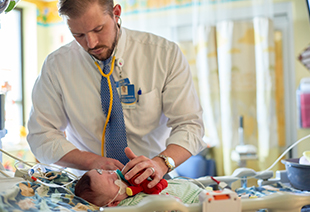Dedicated Team Improves Outcomes for Infants with Bronchopulmonary Dysplasia

The Bronchopulmonary Dysplasia (BPD) Center at Cincinnati Children’s is a regional and national hub for BPD care. The program has reduced mortality, tracheostomies and hospital readmissions for infants with BPD by significant numbers since its start in 2018.
Shawn Ahlfeld, MD, neonatologist with the BPD Center, attributes the improved outcomes to several factors: an interdisciplinary team that meets weekly to discuss patients’ BPD prevention and management, advanced magnetic resonance imaging (MRI) technology that more quickly and clearly identifies infants who need tracheostomy, and ongoing institute-wide preventative quality improvement initiatives.

Clinical Advances
Significant accomplishments in the past year include:
- In babies admitted with moderate to severe BPD, the mortality rate dropped from 20% in 2016 to less than 10% last year.
- Tracheostomies in this population declined from nearly 30% of patients in 2016 to less than 10% of patients in the past year. Ahlfeld notes that MRI technology specially designed for neonates without sedation or radiation “has both reassured us when we suspected a baby did not require tracheostomy and solidified our concerns when they did. The result has been to improve patient selection and reduce time to tracheostomy, ultimately getting babies home sooner.”
- For the third straight year, quality improvement initiatives have resulted in nearly 100% compliance with early, persistent use of bubble CPAP for early noninvasive respiratory support, promoting improved lung development and less mechanical ventilation in these babies.
- Therapists began developmental rounding for neonatal intensive care unit (NICU) babies with BPD to stimulate development. They also encouraged parents to read, interact, and play with their baby and participate in therapies.
Outpatient Follow-Up Leads to Fewer Readmissions
Most babies remain in the NICU for at least three to four months. After discharge, the infants are closely followed by the NICU BPD Follow-Up Clinic, which cares for about 87 patients. The Center’s rate for follow-up visits is 95%. Over the past three years, a combination of relationships built during initial hospitalization and close outpatient follow-up has contributed to a 54% decrease in total re-admissions in the first year of life for all infants discharged on oxygen.
Adding to the year’s successes, according to neonatologist Melissa House, MD, is “a new protocol that provides consistency for oxygen weaning that utilizes home oximetry studies to ensure babies are appropriate to wean from supplemental oxygen overnight.”

